More Than Just a Patch of Dirt: Our Favorite Campgrounds of the Past Year
As we inch closer to a full year of being on the road, we’re starting to look back at
where we’ve been and what we’ve learned. We’ve covered a lot of ground, seen parts
of the country that we didn’t know existed, and slept in every type of place imaginable.
While we stayed in several spots that we wanted to forget before we’d even left, we also
stumbled onto some truly beautiful and welcoming places that made our little tent feel
like a resort. And since 80% or so of our lodging is in camping form, we’ve become
amateur campground connosieurs. Read on for our favorite campgrounds over the past
7500 miles.
Top 5 Public Campgrounds
1. Twanoh State Park – Hood Canal, Washington
We arrived at Twanoh State Park around noon, after only riding 12 or so miles. We
stopped to have lunch and look out over the water. After a relaxing hour-long break,
we decided it was just too amazing a location to pass up and we stayed the night.


Twanoh State Park is part of the Cascade Marine Trail, meaning that it has campsites
that are only available to people who arrive by human power. Given that we arrived by
bicycle (and, thus, human power), we were able to camp in a small space right on the
water’s edge in the day-use portion of the park. We were across the street from the main
campground, meaning that there were no other campers nearby. At dusk, the rangers
locked the gate, and the whole area on the water was left just for us. Waves lapping ten
feet from the picnic table and tent, a rocky beach to explore when the tide is low, a sky
full of stars at night – we felt like we had stumbled onto a little slice of heaven.
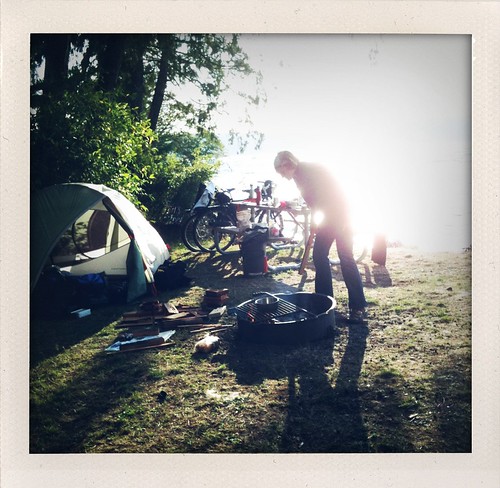
Twanoh is nestled amongst residences along the Hood Canal, meaning that it is relatively
quiet (there is only traffic noise, but it’s relatively light). There are no services nearby,
except for a few mini-marts within 10 miles in either direction (but these mini marts
have locally-caught smoked salmon!). Showers are available in the park, and there is a
small snackbar that’s open during the summer (we thoroughly enjoyed their fudge bars!).
Camping is $14 per night (primitive).
2. Picacho Peak State Park – Arizona
We pulled in to Picacho Peak State Park on our way south into Tucson. It is just off I-
10, to the west, but it is set in the hills several hundred feet above the freeway, making
it blissfully quiet and peaceful. When we first pulled in to the campground, we were
stunned by how beautiful it is and how surprisingly tucked-away you feel.
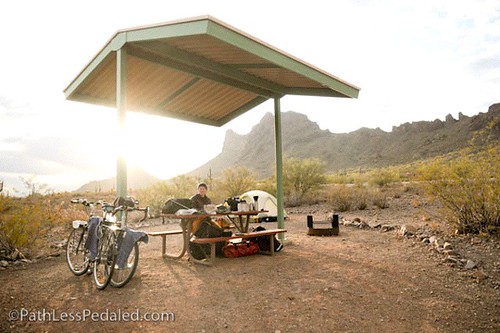
Picacho Peak is a small mountain in the middle of the desert, surrounded by cactus. It
has a beautiful and fascinating history, and there are hiking trails that criss-cross the area,
allowing you to climb up to stunning viewpoints. The campground, itself, is broken into
electric and non-electric sites, meaning that most generator-running RVs are in one area,
and tenters are able to separate themselves from the noise. We chose a spot up on the
hillside, which gave us an amazing view of the valley below and the stars at night. The
facilities at Picacho Peak are brand new, having been recently remodeled to be more
sustainable. The visitor’s center is LEED certified, and the restrooms in the campground
feel like a spa.


Picacho Peak was slated to be closed this spring, due to budgetary shortfalls. However,
I’m happy to say that it looks like a group of concerned Arizonans banded together and
saved the park, so it’s still open for others to enjoy! Camping is $15/night (non-electric),
plus $3 entry fee (if not in automobile).
3. Elk Prairie Campground – Prairie Creek Redwoods, California
The route to Elk Prairie Campground is a small two-lane road that winds through thick
redwood forest. If you’re coming from the North, you coast slowly downhill through the
trees, tucked in a pocket of magical silence. After several miles, the forest opens up to a
clearing – a prairie that is popular with the local elk herd, and a campground.
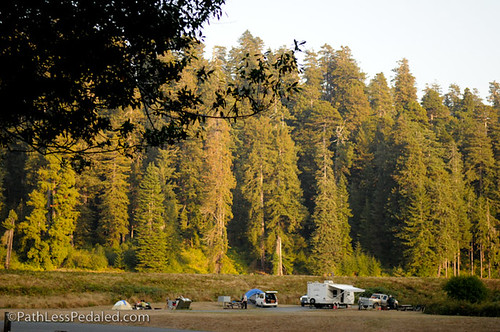
Elk Prairie Campground is right along the very-popular Pacific Coast Bike Route, so
it offers a spectacular hiker/biker camping area, set away from the RVs. It’s a bit of a
walk to the restrooms, but you get front-row seats to the elk that meander through the
prairie (and tussle with each other during Rut in the early fall). If you arrive on bike (or
foot), expect to meet lots of other like-minded travelers. At night, the area is fantastically
dark and quiet (unless the elk are in Rut, in which case you’ll hear them moan and knock
antlers in the dark). Because the campgrouns is located near the ocean (although you
forget because of the trees), fog drifts in and out of the area, making it feel even more
ethereal.


Bear boxes are provided to stash your food and keep the critters away. Showers are
available in the main part of the campground, and require quarters. Camping is $5 per
night person (for hiker/biker).
4. Enchanted Rock State Natural Area – Texas
When we left Austin and headed NW through Hill Country, everyone told us that we
simply had to go to Enchanted Rock State Park. Fine, fine, we said, and plotted our
course through the state park. When we got there, we were so charmed that we ended up
staying two nights, just to have more time to explore and enjoy.


Enchanted Rock State Park is set at the foot of Enchanted Rock, a single and enormous
rock that has been a magical and sacred spot for many. Camping is located at the base
of the rocky cliffs or in a grassy field (we recommend the ones by the rocks). Although
it’s not a long trek, each site is walk-in only (there are no RV hookups), making them feel
particularly secluded and private. Some sites have covered tables, which is great in times
of sun or rain. Water is located in the parking area, so bring some sort of container to
carry it back to your site. Firewood and showers are available, and WiFi can be accessed
at the ranger station.

While you’re there, make sure you carve out time to hike to the top of Enchanted Rock.
It’s a short, steep walk up the face of the rock, and the views from the top are incredible.
If you visit during the spring, you’ll also be treated to beautiful wildflower blooms.
Camping is $15 per night (non-peak times) and $17 per night (peak times), with $6 per
person per day entry fee.
5. Chisos Basin Campground – Big Bend National Park, Texas
Chisos Basin is located in the middle of a mountainous fortress. From the main road
through Big Bend National Park, you climb 5 miles up a steep and winding road, before
reaching the summit and heading1.5 miles down into the 5,400-feet-high valley. From
the campground, you are surrounded on all sides by mountain peaks, making sunset a
truly magical experience.

You have to work to get to Chisos Basin on a bike. You have to really want it. And
when you tip over the edge and soar into the campground, it will literally take your breath
away. This is one of the single most amazingly beautiful locations either of us has ever
been.
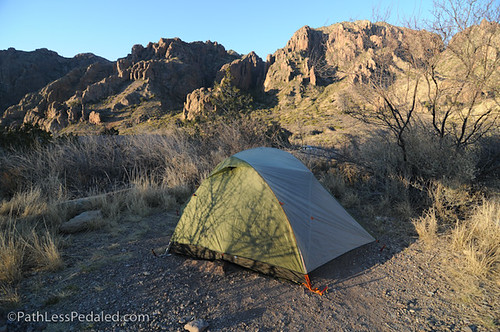

The campground is fairly small, and is predominantly full of people in tents, as many
RVs cannot make the drive. Restrooms and running water are available. There are no
showers, but we felt it was worth it to be dirty to see this place. A short half-mile hike up
the hill takes you to the lodge, visitors center and small store, where you can get a motel
room, eat in a restaurant, buy snacks, and learn about the area. Hikes are available in all
direction. Camping is $8 per night.
Top 5 Private Campgrounds
1. Fall Hollow Campground – Hohenwald, Tennessee (off Natchez Trace Parkway)
Nearing the end of our Natchez Trace adventure, we stumbled onto Fall Hollow
Campground. It was a hot afternoon and we were tired, so we very much enjoyed seeing
a bicycle hanging from the ‘campground open’ sign. Bill and Kathy enthusiastically
welcomed us, gave us some iced tea, and asked about our trip. We quickly became
enamored of this place.


Fall Hollow is a lovely campground. Nestled into the rolling green hills, with plenty
of trees and a creek winding along the back of the property. It’s quiet, relaxing, clean,
and friendly. Cyclists are definitely welcome here. On Thursday, Friday and Saturday
nights, Fall Hollow also operates a restaurant, open for dinner. The food is delicious and
well worth reconfiguring a trip to be sure to be there on one of those evenings. Showers
are available, although a dip in the cold-water creek may be more refreshing on a hot
afternoon.

Fall Hollow is extremely convenient if you’re cycling the Natchez Trace, and should be
a destination for all road-weary travelers (cyclists, make sure you add your name to the
map!). $5 per person per night.
2. Pleasure Point Marina – Lake Claiborne, Louisiana
Our stop at Pleasure Point Marina was complete coincidence and serendipity, as most
great things are. We met Russell (the owner) in the nearby town of Homer and he invited
us down for the weekend, instead of simply stopping at the state park. As we pitched our
tent just ten feet from the edge of the lake, we were thrilled by this change of plans.
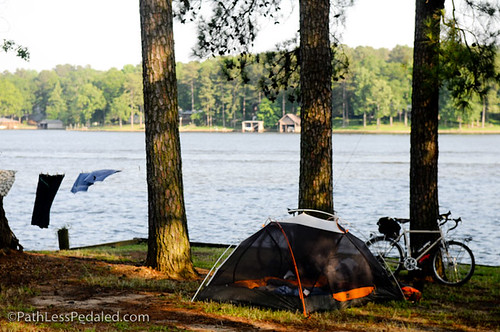
Pleasure Point is mainly an RV camp, but tenters are also welcome. There are very
loose delineations between sites, so everyone is friendly with their neighbors, and we
enjoyed chatting with the guy camped next to us. The campground is located at the
end of a small point of land that juts out into Lake Claiborne. On a hot day, you can
sit under the shade of the big trees and enjoy the cool breeze that blows across the lake.
When it gets too hot, go inside the air-conditioned café for a cold drink. The café serves
some of the best hamburgers around, and now you can get a beer or a margarita with
it. We started dubbing Pleasure Point “summer camp for adults,” because it was such
a beautiful and relaxing spot, and because the drinks at the bar were so very enticing.
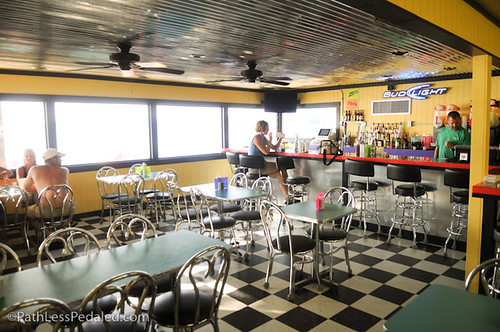

3. Las Ruinas Camping Hostel – Terlingua Ghost Town, Texas
When we rolled into the Terlingua-Study Butte area near Big Bend National Park, we
assumed that we would just stay in a cheap motel for the night, assuming that there were
no “official” camping options. Then we learned about Las Ruinas, and were delighted by
this brand new and absolutely wonderful spot.


Las Ruinas is a hostel, but they don’t offer beds for you to sleep in, you have to come
prepared to camp. If you don’t have your own tent, you can stay in one of their soft-
sided cabins, but there’s no furniture inside and they don’t provide sheets. If you do
have your own tent, you can pitch it in a little corner of the desert landscape. Las
Ruinas has WiFi, a shower and restrooms, an outdoor kitchen, and an old bus that
has been converted into a living room/game room/movie room. One of the greatest
assets of Las Ruinas is its location. It’s right in Terlingua Ghost Town, which is the
old mining camp that was abandoned and is now being revitalized. A five-minute
walk will take you to the Starlight Theatre for dinner. Then grab a beer and sit outside
on the long porch and watch the sunset and listen to the locals tell some wild stories.
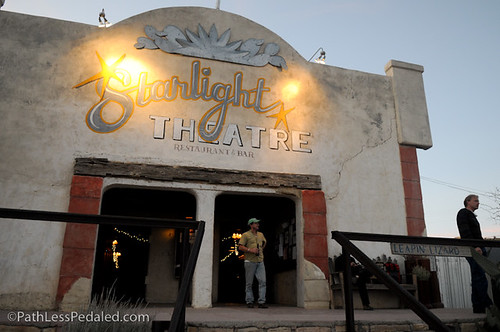
The Big Bend region of Texas should be on everyone’s list of must-visit locations. And
when you come to Terlingua, stay here.
4. Rusty’s RV Ranch – Rodeo, New Mexico
When we headed east from Bisbee, Arizona, we knew that we wanted to stay as far
south as possible, so we chose Hwy 80 and Hwy 9, and we prepared ourselves for a very
empty length of road. Fortunately, at the junction of the two highways is the small town
of Rodeo, New Mexico. And a few years back, Rusty opened her RV Ranch, enticing
travelers to this beautifully empty desert scenery.

We arrived late in the afternoon, tired from a long day of riding into a headwind,
dreading the cold night ahead of us – and Rusty welcomed us with a smile. She opened
her RV Ranch just a few years ago, on a small plot of desert land, in the foothills
of the stunning Chiricahua Mountains. There is a small patch of grass behind the
office where she puts folks in tents (amazingly, we weren’t the first folks she’d seen
arrive on bicycles). The office also has WiFi and a restroom with a shower, so it’s a
wonderfully convenient space to camp out. Because the temperatures were supposed
to drop into the low 20s that night, Rusty moved her small portable heater into the
bathroom, so that we could shower in a warm room and have a place to take the chill off.
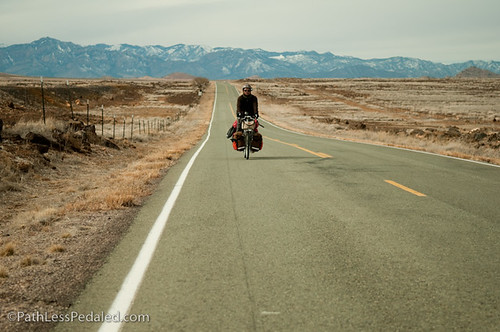
In the morning, we had our coffee and breakfast in the office and chatted with Rusty
and some other travelers. It was a wonderful gem of a place in the middle of nowhere.
Camping $24.
5. Manchester Beach KOA – Manchester Beach, California
Manchester Beach is along Hwy 1 on the Northern California coast. The area is beautiful
and rugged. The state parks, however, leave a lot to be desired. When we rolled into
Manchester Beach State Park, we discovered a bland campground with only pit toilets
and no other facilities. While we waited for the camp hosts to return to change our $20
bill, Russ rode back up the road a half mile to the KOA next door, to see if they had a
market with cold drinks. He discovered a beautiful campground with a great hiker/biker
deal.

The Manchester Beach KOA has to be the only KOA in the US that offers a hiker/
biker discount and one of the few that doesn’t completely rip you off. For $9 per night
per person, you have complete access to their wonderful facility – including a kitchen
with gas grills, hot showers, laundry, a pool and a hot tub (which my sore muscles were
extremely thankful for). More than all the above, because they offered a great hiker/biker
deal, all the bike tourists that were camping in that stretch of coastline that night were
set up at the KOA. We shared space with at least a half dozen other people and swapped
stories into the evening.


The difference between the KOA and the state park was so stark that it was an
instantaneous decision, and we felt it was well worth the extra few dollars. If you’re
planning a trip down this stretch of road, we highly suggest the KOA over the state park.
Tags In
5 Comments
Leave a Reply to Phil
This site uses Akismet to reduce spam. Learn how your comment data is processed.
Subscribe
Patreon
Join Team Supple on Patreon
PayPal

Hi Laura! It’s been quite a while since I’ve visited and I’m so glad to have bumped into you again during this great review. You’ve seen so many sights and had so many wonderful adventures. So inspiring. Not enough that I’ll hike my 53 year old bones up on a bicycle, but enough to dream the afternoon away.
😀
Wow — I’ve ridden past and stopped for a break at Twanoh many times, but I’ve never camped there. I’m usually on my way to the Olympics.
I’ve always thought Washington’s fee of $14 for a primitive site to be ridiculous. Oregon charges $4 per person!
I ran across your website from a link from Kent Peterson. Lots of useful and interesting information. Thanks for sharing. I love your write ups. My wife and I have been discussing bike touring lately. You make it look like a lot of fun.
I’ve camped many times at Chisos Basin and continue to regard it as one of the most incredible sites (comparisons: NE/Appalachians, northern Rockies). There are a lot of beautiful campgrounds, but Chisos Basin near sunset (and at Sunrise when it’s coming up over those finger-like rocks) is other-worldly.
Glad ya’ll found Rusty’s outside Rodeo. I stayed there on a tour from Bisbee to Alpine, TX. Great option. Hope ya’ll are doing well. Keep Riding!